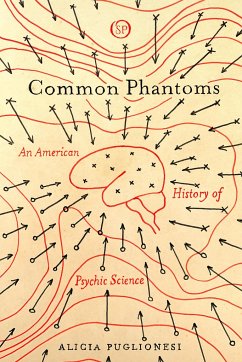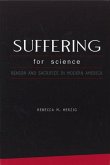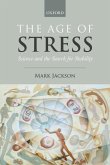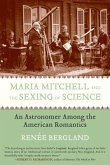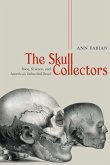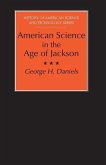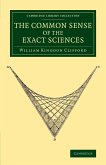- Broschiertes Buch
- Merkliste
- Auf die Merkliste
- Bewerten Bewerten
- Teilen
- Produkt teilen
- Produkterinnerung
- Produkterinnerung
"Modeling a new approach to the history of psychology and the mind sciences, this book brings to life the seances, deathbed communions, flashes of clairvoyance, and telepathic experiments that captivated the American public from the 1860s well into the twentieth century. The book contextualizes psychical research, an unorthodox 'science of the soul,' within a long history of citizen science in the United States. Rather than a superstitious impediment to the progress of laboratory psychology, psychical research belongs to a continuous tradition of knowledge production by ordinary people in everyday settings"…mehr
Andere Kunden interessierten sich auch für
![Suffering for Science Suffering for Science]() Rebecca HerzigSuffering for Science44,99 €
Rebecca HerzigSuffering for Science44,99 €![Age of Stress Age of Stress]() Mark JacksonAge of Stress56,99 €
Mark JacksonAge of Stress56,99 €![The Ascent of Affect The Ascent of Affect]() Ruth LeysThe Ascent of Affect46,99 €
Ruth LeysThe Ascent of Affect46,99 €![Maria Mitchell and the Sexing of Science Maria Mitchell and the Sexing of Science]() Renee BerglandMaria Mitchell and the Sexing of Science21,99 €
Renee BerglandMaria Mitchell and the Sexing of Science21,99 €![The Skull Collectors The Skull Collectors]() Ann FabianThe Skull Collectors28,99 €
Ann FabianThe Skull Collectors28,99 €![American Science in the Age of Jackson American Science in the Age of Jackson]() George H. DanielsAmerican Science in the Age of Jackson43,99 €
George H. DanielsAmerican Science in the Age of Jackson43,99 €![The Common Sense of the Exact Sciences The Common Sense of the Exact Sciences]() William Kingdon CliffordThe Common Sense of the Exact Sciences41,99 €
William Kingdon CliffordThe Common Sense of the Exact Sciences41,99 €-
-
-
"Modeling a new approach to the history of psychology and the mind sciences, this book brings to life the seances, deathbed communions, flashes of clairvoyance, and telepathic experiments that captivated the American public from the 1860s well into the twentieth century. The book contextualizes psychical research, an unorthodox 'science of the soul,' within a long history of citizen science in the United States. Rather than a superstitious impediment to the progress of laboratory psychology, psychical research belongs to a continuous tradition of knowledge production by ordinary people in everyday settings"
Hinweis: Dieser Artikel kann nur an eine deutsche Lieferadresse ausgeliefert werden.
Hinweis: Dieser Artikel kann nur an eine deutsche Lieferadresse ausgeliefert werden.
Produktdetails
- Produktdetails
- Verlag: Stanford University Press
- Seitenzahl: 336
- Erscheinungstermin: 25. August 2020
- Englisch
- Abmessung: 224mm x 150mm x 22mm
- Gewicht: 460g
- ISBN-13: 9781503612778
- ISBN-10: 1503612775
- Artikelnr.: 57170194
- Herstellerkennzeichnung
- Libri GmbH
- Europaallee 1
- 36244 Bad Hersfeld
- gpsr@libri.de
- Verlag: Stanford University Press
- Seitenzahl: 336
- Erscheinungstermin: 25. August 2020
- Englisch
- Abmessung: 224mm x 150mm x 22mm
- Gewicht: 460g
- ISBN-13: 9781503612778
- ISBN-10: 1503612775
- Artikelnr.: 57170194
- Herstellerkennzeichnung
- Libri GmbH
- Europaallee 1
- 36244 Bad Hersfeld
- gpsr@libri.de
Alicia Puglionesi is author of the novella Krall Krall (2013) and the poetry chapbook Views from the National Forests (2014). She has published in The Point, Atlas Obscura, The Public Domain Review, and the VICE magazine Motherboard.
Contents and Abstracts
Introduction: At Home, with Ghosts
chapter abstract
Provides an overview of the book's contents. Broadly, the book tracks the
séances, deathbed communions, flashes of clairvoyance, and telepathic
experiments that bound together the lives of ordinary Americans from the
1860s well into the twentieth century. Or rather, it follows Americans as
they chased these strange phenomena across boundaries of gender, race, and
mental illness. Psychical research, a field of study that emerged
specifically to make sense of experiences that defied explanation, relied
on a far-flung network of participants to collect its "wild facts." Most
were not trained scientists, but all believed that a scientific approach
was the best way to discover the true nature of the mind and, perhaps, the
soul. This book tells the story of their failure to produce an orthodox
science and explores the often neglected relational phenomena that they did
successfully generate.
1The Weather Map at the Bottom of the Mind
chapter abstract
The American Society for Psychical Research (ASPR) looked to the iconic
field sciences of the nineteenth century for both methods and metaphors,
organizational strategies, and epistemological foundations. This chapter
considers the influence of meteorology and astronomy on psychical research.
All three sciences faced a similar challenge: how to identify and fix
fleeting phenomena encountered only in their indirect emanations. They all
grappled with the problem of the "personal equation," a certain degree of
inevitable perceptual variability among observers. By self-consciously
adopting meteorology and astronomy as models, ASPR leaders not only
asserted the feasibility of capturing the invisible, they also sought to
counter the materialist orthodoxy of the lab. William James, especially,
saw individual mental events as inextricable from the context in which they
occurred-a context impossible to reproduce under artificially controlled
conditions. It was no more realistic to study the mind in a laboratory than
to study a tornado in a test tube.
2Machines That Dream Together
chapter abstract
The scientific study of dreams offers a window into nineteenth-century
views about the unconscious and the nature of the mind. Competing models of
mind proposed by psychologists and psychical researchers had serious
implications for human relations, politics, and commerce. New communication
channels like the telegraph facilitated the spread of ideas and impressions
with unprecedented speed. Psychical research suggested that ideas could
spread of their own accord, along mysterious wavelengths that eluded human
control. This would badly undermine the notion of intellectual property,
not to mention the "marketplace of ideas" where rational consumers
deliberate over their commitments. Radical utopians saw a path to progress
and uplift, while conservatives saw a volatile threat to the social order.
Though some dismissed thought-transference and telepathy as preposterous,
the strength of the anecdotal tradition around such events led serious
psychologists and philosophers to speculate on their meaning.
3Drawings from the Other Side
chapter abstract
Psychical researchers did not merely imitate the techniques of objectivity
emerging in academic psychology, they helped to articulate new experimental
practices for accessing the unconscious mind. This chapter explores the
influence of psychical research on the development of drawing tasks as a
psychometric and clinical tool. While psychical researchers used drawing to
test the permeability of the mind, it was embraced in mainstream psychology
as a way to bypass the patient's subjectivity and access the brain's inner
workings. The widespread use of drawing in psychometrics, neuropsychology,
and psychotherapy takes on a new significance when we understand its roots
in psychical research: an experiment meant to join two minds in communion
became a routine tool for examining solitary brains.
4Psychic Domesticity
chapter abstract
This chapter focuses on the role of intimacy in the psychical research
career of Mary Craig Sinclair and her husband, the novelist Upton Sinclair.
Mary Craig Sinclair's story encapsulates issues of gender, witnessing, and
subjectivity. She began with studies of a stage medium, Count Ostoja, which
reversed the Gothic script of Svengali-like psychic invasion by placing
Sinclair in the position of superior mental power. After this scandalous
episode, Sinclair retreated to the home and to the dyad of the married
couple, where she began a long-running experiment as a recipient of her
husband's telepathic messages. Returning to the normative gender dynamic
that her initial research had disrupted, she was able to win the acceptance
of leading psychical researchers and psychologists.
5The Wilderness of Insanity
chapter abstract
Psychical research was constantly negotiating the boundaries of
sanity-sometimes in a communal and democratic way, sometimes in a clinical
and authoritarian way. To pursue the real into a wilderness where
perceptions could deceive, it had to standardize its sources within a
certain range of reliability. The concept of neurasthenia allowed
investigators to distinguish between subjects with compromised mental
faculties and those with physiological troubles that did not negate their
ability to testify. However, this differentiation had no fixed or clearly
articulated criteria. Widespread anxiety over neurasthenia was chipping
away at the very notion of mental normalcy, and radical experiments in
Spiritualism, psychical research, and parapsychology further blurred the
"vague boundary" between the well and the sick, scientists and subjects.
Conclusion: To Keep Alive and Heap Up Data
chapter abstract
Histories of psychology have long framed psychical research as a necessary
failure, a last gasp of magical thinking that had to be purified out in
order for the mind sciences to become truly scientific. The book's
conclusion reevaluates the failure narrative, arguing that psychical
research gave participants valuable tools with which to probe their
experiences on their own terms. In its successes as well as its struggles
for legitimacy, psychical research illustrates the contextual nature of
science and the permeability of the self. James and his many correspondents
tried to stabilize a normative understanding of what it means to be an
experiencer, an observer, and a citizen. At the same time, their intimate
exposures transgressed the boundaries of the individual and called into
question the unity of reality itself.
Introduction: At Home, with Ghosts
chapter abstract
Provides an overview of the book's contents. Broadly, the book tracks the
séances, deathbed communions, flashes of clairvoyance, and telepathic
experiments that bound together the lives of ordinary Americans from the
1860s well into the twentieth century. Or rather, it follows Americans as
they chased these strange phenomena across boundaries of gender, race, and
mental illness. Psychical research, a field of study that emerged
specifically to make sense of experiences that defied explanation, relied
on a far-flung network of participants to collect its "wild facts." Most
were not trained scientists, but all believed that a scientific approach
was the best way to discover the true nature of the mind and, perhaps, the
soul. This book tells the story of their failure to produce an orthodox
science and explores the often neglected relational phenomena that they did
successfully generate.
1The Weather Map at the Bottom of the Mind
chapter abstract
The American Society for Psychical Research (ASPR) looked to the iconic
field sciences of the nineteenth century for both methods and metaphors,
organizational strategies, and epistemological foundations. This chapter
considers the influence of meteorology and astronomy on psychical research.
All three sciences faced a similar challenge: how to identify and fix
fleeting phenomena encountered only in their indirect emanations. They all
grappled with the problem of the "personal equation," a certain degree of
inevitable perceptual variability among observers. By self-consciously
adopting meteorology and astronomy as models, ASPR leaders not only
asserted the feasibility of capturing the invisible, they also sought to
counter the materialist orthodoxy of the lab. William James, especially,
saw individual mental events as inextricable from the context in which they
occurred-a context impossible to reproduce under artificially controlled
conditions. It was no more realistic to study the mind in a laboratory than
to study a tornado in a test tube.
2Machines That Dream Together
chapter abstract
The scientific study of dreams offers a window into nineteenth-century
views about the unconscious and the nature of the mind. Competing models of
mind proposed by psychologists and psychical researchers had serious
implications for human relations, politics, and commerce. New communication
channels like the telegraph facilitated the spread of ideas and impressions
with unprecedented speed. Psychical research suggested that ideas could
spread of their own accord, along mysterious wavelengths that eluded human
control. This would badly undermine the notion of intellectual property,
not to mention the "marketplace of ideas" where rational consumers
deliberate over their commitments. Radical utopians saw a path to progress
and uplift, while conservatives saw a volatile threat to the social order.
Though some dismissed thought-transference and telepathy as preposterous,
the strength of the anecdotal tradition around such events led serious
psychologists and philosophers to speculate on their meaning.
3Drawings from the Other Side
chapter abstract
Psychical researchers did not merely imitate the techniques of objectivity
emerging in academic psychology, they helped to articulate new experimental
practices for accessing the unconscious mind. This chapter explores the
influence of psychical research on the development of drawing tasks as a
psychometric and clinical tool. While psychical researchers used drawing to
test the permeability of the mind, it was embraced in mainstream psychology
as a way to bypass the patient's subjectivity and access the brain's inner
workings. The widespread use of drawing in psychometrics, neuropsychology,
and psychotherapy takes on a new significance when we understand its roots
in psychical research: an experiment meant to join two minds in communion
became a routine tool for examining solitary brains.
4Psychic Domesticity
chapter abstract
This chapter focuses on the role of intimacy in the psychical research
career of Mary Craig Sinclair and her husband, the novelist Upton Sinclair.
Mary Craig Sinclair's story encapsulates issues of gender, witnessing, and
subjectivity. She began with studies of a stage medium, Count Ostoja, which
reversed the Gothic script of Svengali-like psychic invasion by placing
Sinclair in the position of superior mental power. After this scandalous
episode, Sinclair retreated to the home and to the dyad of the married
couple, where she began a long-running experiment as a recipient of her
husband's telepathic messages. Returning to the normative gender dynamic
that her initial research had disrupted, she was able to win the acceptance
of leading psychical researchers and psychologists.
5The Wilderness of Insanity
chapter abstract
Psychical research was constantly negotiating the boundaries of
sanity-sometimes in a communal and democratic way, sometimes in a clinical
and authoritarian way. To pursue the real into a wilderness where
perceptions could deceive, it had to standardize its sources within a
certain range of reliability. The concept of neurasthenia allowed
investigators to distinguish between subjects with compromised mental
faculties and those with physiological troubles that did not negate their
ability to testify. However, this differentiation had no fixed or clearly
articulated criteria. Widespread anxiety over neurasthenia was chipping
away at the very notion of mental normalcy, and radical experiments in
Spiritualism, psychical research, and parapsychology further blurred the
"vague boundary" between the well and the sick, scientists and subjects.
Conclusion: To Keep Alive and Heap Up Data
chapter abstract
Histories of psychology have long framed psychical research as a necessary
failure, a last gasp of magical thinking that had to be purified out in
order for the mind sciences to become truly scientific. The book's
conclusion reevaluates the failure narrative, arguing that psychical
research gave participants valuable tools with which to probe their
experiences on their own terms. In its successes as well as its struggles
for legitimacy, psychical research illustrates the contextual nature of
science and the permeability of the self. James and his many correspondents
tried to stabilize a normative understanding of what it means to be an
experiencer, an observer, and a citizen. At the same time, their intimate
exposures transgressed the boundaries of the individual and called into
question the unity of reality itself.
Contents and Abstracts
Introduction: At Home, with Ghosts
chapter abstract
Provides an overview of the book's contents. Broadly, the book tracks the
séances, deathbed communions, flashes of clairvoyance, and telepathic
experiments that bound together the lives of ordinary Americans from the
1860s well into the twentieth century. Or rather, it follows Americans as
they chased these strange phenomena across boundaries of gender, race, and
mental illness. Psychical research, a field of study that emerged
specifically to make sense of experiences that defied explanation, relied
on a far-flung network of participants to collect its "wild facts." Most
were not trained scientists, but all believed that a scientific approach
was the best way to discover the true nature of the mind and, perhaps, the
soul. This book tells the story of their failure to produce an orthodox
science and explores the often neglected relational phenomena that they did
successfully generate.
1The Weather Map at the Bottom of the Mind
chapter abstract
The American Society for Psychical Research (ASPR) looked to the iconic
field sciences of the nineteenth century for both methods and metaphors,
organizational strategies, and epistemological foundations. This chapter
considers the influence of meteorology and astronomy on psychical research.
All three sciences faced a similar challenge: how to identify and fix
fleeting phenomena encountered only in their indirect emanations. They all
grappled with the problem of the "personal equation," a certain degree of
inevitable perceptual variability among observers. By self-consciously
adopting meteorology and astronomy as models, ASPR leaders not only
asserted the feasibility of capturing the invisible, they also sought to
counter the materialist orthodoxy of the lab. William James, especially,
saw individual mental events as inextricable from the context in which they
occurred-a context impossible to reproduce under artificially controlled
conditions. It was no more realistic to study the mind in a laboratory than
to study a tornado in a test tube.
2Machines That Dream Together
chapter abstract
The scientific study of dreams offers a window into nineteenth-century
views about the unconscious and the nature of the mind. Competing models of
mind proposed by psychologists and psychical researchers had serious
implications for human relations, politics, and commerce. New communication
channels like the telegraph facilitated the spread of ideas and impressions
with unprecedented speed. Psychical research suggested that ideas could
spread of their own accord, along mysterious wavelengths that eluded human
control. This would badly undermine the notion of intellectual property,
not to mention the "marketplace of ideas" where rational consumers
deliberate over their commitments. Radical utopians saw a path to progress
and uplift, while conservatives saw a volatile threat to the social order.
Though some dismissed thought-transference and telepathy as preposterous,
the strength of the anecdotal tradition around such events led serious
psychologists and philosophers to speculate on their meaning.
3Drawings from the Other Side
chapter abstract
Psychical researchers did not merely imitate the techniques of objectivity
emerging in academic psychology, they helped to articulate new experimental
practices for accessing the unconscious mind. This chapter explores the
influence of psychical research on the development of drawing tasks as a
psychometric and clinical tool. While psychical researchers used drawing to
test the permeability of the mind, it was embraced in mainstream psychology
as a way to bypass the patient's subjectivity and access the brain's inner
workings. The widespread use of drawing in psychometrics, neuropsychology,
and psychotherapy takes on a new significance when we understand its roots
in psychical research: an experiment meant to join two minds in communion
became a routine tool for examining solitary brains.
4Psychic Domesticity
chapter abstract
This chapter focuses on the role of intimacy in the psychical research
career of Mary Craig Sinclair and her husband, the novelist Upton Sinclair.
Mary Craig Sinclair's story encapsulates issues of gender, witnessing, and
subjectivity. She began with studies of a stage medium, Count Ostoja, which
reversed the Gothic script of Svengali-like psychic invasion by placing
Sinclair in the position of superior mental power. After this scandalous
episode, Sinclair retreated to the home and to the dyad of the married
couple, where she began a long-running experiment as a recipient of her
husband's telepathic messages. Returning to the normative gender dynamic
that her initial research had disrupted, she was able to win the acceptance
of leading psychical researchers and psychologists.
5The Wilderness of Insanity
chapter abstract
Psychical research was constantly negotiating the boundaries of
sanity-sometimes in a communal and democratic way, sometimes in a clinical
and authoritarian way. To pursue the real into a wilderness where
perceptions could deceive, it had to standardize its sources within a
certain range of reliability. The concept of neurasthenia allowed
investigators to distinguish between subjects with compromised mental
faculties and those with physiological troubles that did not negate their
ability to testify. However, this differentiation had no fixed or clearly
articulated criteria. Widespread anxiety over neurasthenia was chipping
away at the very notion of mental normalcy, and radical experiments in
Spiritualism, psychical research, and parapsychology further blurred the
"vague boundary" between the well and the sick, scientists and subjects.
Conclusion: To Keep Alive and Heap Up Data
chapter abstract
Histories of psychology have long framed psychical research as a necessary
failure, a last gasp of magical thinking that had to be purified out in
order for the mind sciences to become truly scientific. The book's
conclusion reevaluates the failure narrative, arguing that psychical
research gave participants valuable tools with which to probe their
experiences on their own terms. In its successes as well as its struggles
for legitimacy, psychical research illustrates the contextual nature of
science and the permeability of the self. James and his many correspondents
tried to stabilize a normative understanding of what it means to be an
experiencer, an observer, and a citizen. At the same time, their intimate
exposures transgressed the boundaries of the individual and called into
question the unity of reality itself.
Introduction: At Home, with Ghosts
chapter abstract
Provides an overview of the book's contents. Broadly, the book tracks the
séances, deathbed communions, flashes of clairvoyance, and telepathic
experiments that bound together the lives of ordinary Americans from the
1860s well into the twentieth century. Or rather, it follows Americans as
they chased these strange phenomena across boundaries of gender, race, and
mental illness. Psychical research, a field of study that emerged
specifically to make sense of experiences that defied explanation, relied
on a far-flung network of participants to collect its "wild facts." Most
were not trained scientists, but all believed that a scientific approach
was the best way to discover the true nature of the mind and, perhaps, the
soul. This book tells the story of their failure to produce an orthodox
science and explores the often neglected relational phenomena that they did
successfully generate.
1The Weather Map at the Bottom of the Mind
chapter abstract
The American Society for Psychical Research (ASPR) looked to the iconic
field sciences of the nineteenth century for both methods and metaphors,
organizational strategies, and epistemological foundations. This chapter
considers the influence of meteorology and astronomy on psychical research.
All three sciences faced a similar challenge: how to identify and fix
fleeting phenomena encountered only in their indirect emanations. They all
grappled with the problem of the "personal equation," a certain degree of
inevitable perceptual variability among observers. By self-consciously
adopting meteorology and astronomy as models, ASPR leaders not only
asserted the feasibility of capturing the invisible, they also sought to
counter the materialist orthodoxy of the lab. William James, especially,
saw individual mental events as inextricable from the context in which they
occurred-a context impossible to reproduce under artificially controlled
conditions. It was no more realistic to study the mind in a laboratory than
to study a tornado in a test tube.
2Machines That Dream Together
chapter abstract
The scientific study of dreams offers a window into nineteenth-century
views about the unconscious and the nature of the mind. Competing models of
mind proposed by psychologists and psychical researchers had serious
implications for human relations, politics, and commerce. New communication
channels like the telegraph facilitated the spread of ideas and impressions
with unprecedented speed. Psychical research suggested that ideas could
spread of their own accord, along mysterious wavelengths that eluded human
control. This would badly undermine the notion of intellectual property,
not to mention the "marketplace of ideas" where rational consumers
deliberate over their commitments. Radical utopians saw a path to progress
and uplift, while conservatives saw a volatile threat to the social order.
Though some dismissed thought-transference and telepathy as preposterous,
the strength of the anecdotal tradition around such events led serious
psychologists and philosophers to speculate on their meaning.
3Drawings from the Other Side
chapter abstract
Psychical researchers did not merely imitate the techniques of objectivity
emerging in academic psychology, they helped to articulate new experimental
practices for accessing the unconscious mind. This chapter explores the
influence of psychical research on the development of drawing tasks as a
psychometric and clinical tool. While psychical researchers used drawing to
test the permeability of the mind, it was embraced in mainstream psychology
as a way to bypass the patient's subjectivity and access the brain's inner
workings. The widespread use of drawing in psychometrics, neuropsychology,
and psychotherapy takes on a new significance when we understand its roots
in psychical research: an experiment meant to join two minds in communion
became a routine tool for examining solitary brains.
4Psychic Domesticity
chapter abstract
This chapter focuses on the role of intimacy in the psychical research
career of Mary Craig Sinclair and her husband, the novelist Upton Sinclair.
Mary Craig Sinclair's story encapsulates issues of gender, witnessing, and
subjectivity. She began with studies of a stage medium, Count Ostoja, which
reversed the Gothic script of Svengali-like psychic invasion by placing
Sinclair in the position of superior mental power. After this scandalous
episode, Sinclair retreated to the home and to the dyad of the married
couple, where she began a long-running experiment as a recipient of her
husband's telepathic messages. Returning to the normative gender dynamic
that her initial research had disrupted, she was able to win the acceptance
of leading psychical researchers and psychologists.
5The Wilderness of Insanity
chapter abstract
Psychical research was constantly negotiating the boundaries of
sanity-sometimes in a communal and democratic way, sometimes in a clinical
and authoritarian way. To pursue the real into a wilderness where
perceptions could deceive, it had to standardize its sources within a
certain range of reliability. The concept of neurasthenia allowed
investigators to distinguish between subjects with compromised mental
faculties and those with physiological troubles that did not negate their
ability to testify. However, this differentiation had no fixed or clearly
articulated criteria. Widespread anxiety over neurasthenia was chipping
away at the very notion of mental normalcy, and radical experiments in
Spiritualism, psychical research, and parapsychology further blurred the
"vague boundary" between the well and the sick, scientists and subjects.
Conclusion: To Keep Alive and Heap Up Data
chapter abstract
Histories of psychology have long framed psychical research as a necessary
failure, a last gasp of magical thinking that had to be purified out in
order for the mind sciences to become truly scientific. The book's
conclusion reevaluates the failure narrative, arguing that psychical
research gave participants valuable tools with which to probe their
experiences on their own terms. In its successes as well as its struggles
for legitimacy, psychical research illustrates the contextual nature of
science and the permeability of the self. James and his many correspondents
tried to stabilize a normative understanding of what it means to be an
experiencer, an observer, and a citizen. At the same time, their intimate
exposures transgressed the boundaries of the individual and called into
question the unity of reality itself.

